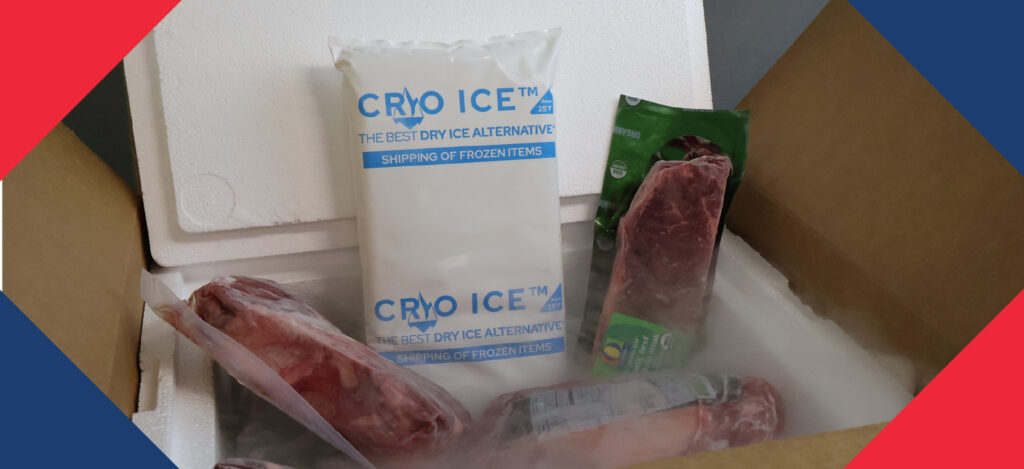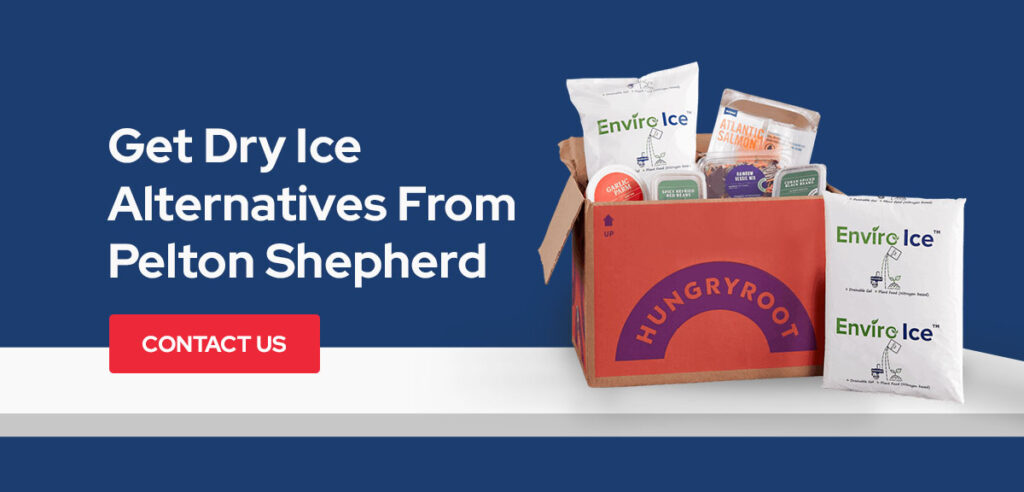
Dry ice has long been the go-to solution for shipping frozen foods and certain pharmaceuticals due to its extremely low surface temperature of around -109.3 F. However, the dangers associated with that temperature and the sublimation process make it a hazardous shipping material.
With the increased demand for direct-to-consumer perishables like ready-to-cook meal kits and B2C pharmaceuticals, many companies stand to benefit from safer dry ice alternatives. Growing societal and regulatory pressure to adopt sustainable practices has also propelled cold chain businesses to find eco-friendly and cost-effective alternatives to dry ice.
The good news is that recent technological developments have created sustainable, economical and safe product options that can serve as dry ice alternatives when shipping cold and frozen goods. These products can replace dry ice when extreme cold isn’t necessary.
Why Is Dry Ice a Poor Cold Chain Solution?
While dry ice does get very cold, there are better solutions for shipping frozen goods. The chemical structure of dry ice causes it to sublimate quickly, which means that a large quantity is often needed during shipping, and it is difficult to keep sufficient quantities on hand. This scarcity leads to surges in pricing and supply issues during times of high demand.
Other reasons why dry ice is not the best option for shipping perishables are:
- Poses safety hazards: With its ultracold surface temperature, dry ice can cause frostbite if handled without personal protective equipment. Additionally, as solid dry ice sublimates and converts into carbon dioxide vapor, it can build up within a shipping container or poorly ventilated space, creating the risk of asphyxiation or explosion.
- Requires adherence to strict regulations: Since dry ice is considered a Class 9 hazardous material, cold chain shippers must comply with regulations enforced by the Department of Transportation and the International Air Transport Association when shipping products by air or water. This includes following packaging, labeling and documentation procedures.
- Demands hazmat training: Anyone who works with dry ice must be trained on proper handling, storing and packaging procedures to avoid injuries and potentially fatal accidents. Training must include learning how to pack products to enable adequate vapor release and keep everyone in the supply chain safe.
All of the above factors require time, effort and resources — which can be bypassed by choosing dry ice alternatives.
Is There an Alternative to Dry Ice?
Yes — you can ship perishables, including frozen foods, with specially formulated gel packs instead of dry ice. Shipping with cold packs is a safe alternative that can allow you better control over your cold chain while providing environmental benefits at a cost-effective price.
For example, Pelton Shepherd has developed Cryo Ice™ gel packs with a special formulation that keeps its temperature below 25F during thawing. Cryo Ice™ is a safe and reliable refrigerant solution designed for shipping frozen foods or pharmaceuticals requiring precise temperature control. Shipping with Cryo Ice™ gel packs does not require special training or adherence to hazardous material regulations.
Although it’s recommended that employees wear gloves when handling Cryo Ice™ gel packs due to their low surface temperature, unlike dry ice, they do not pose a frostbite risk under regular use. Employees can handle Cryo Ice™ easily and with peace of mind.
On top of its safety and environmental benefits, Cryo Ice™ is the best ice pack to replace dry ice because it can be pre-frozen and packed out in advance of shipping to assist in level loading production, eliminating the hassle of rushing to beat dry ice sublimation. The ice packs also retain their shape better than competitors due to Pelton Shepherd’s packaging and care during the manufacturing process, resulting in more efficient and consistent pack-outs.
Dry Ice Alternative FAQs
Have questions? Learn more about gel packs as dry ice alternatives below, or contact our team — we’re happy to help.
While it is possible to make dry ice at home, it is not recommended. Making dry ice can be dangerous and is best left to professionals.
Dry ice is made of just one ingredient, carbon dioxide (CO2). Dry ice is simply solid carbon dioxide.
Technically, yes. However, dry ice turns into a gas at -109.3 degrees Fahrenheit, so you would need special equipment to reuse it.
If you have leftover dry ice that you want to get rid of, leave it out in a well-ventilated area at room temperature and the dry ice will return back to a gaseous state. Be sure to leave dry ice in a disposable container while you do this.
While dry ice will not harm your drink if used to cool it, you do not want to consume dry ice in it’s solid form. Since dry ice is only either a solid or a gas, it will not turn into a liquid that will mix with your drink. In short, consuming dry ice is toxic and touching it with your bare skin can be damaging.
It all depends on the temperature it is stored in. Dry ice will typically last 18-24 hours in a cool environment, 3 hours outdoors, and 30-45 minutes in a liquid. If you use dry ice for shipping, you will want to use at least a 5 pound block.
For cold chain shipping, ice packs are often better than dry ice because they offer higher reliability, are much safer to handle and ship, and do not require special packaging or storage procedures, making them more cost-effective.
Shipping gel packs mainly contain water and an absorbent gel-forming substance such as sodium polyacrylate. These ingredients work together to produce a flexible shipping solution that evenly distributes cooling effects and prevents temperature excursions.
In general, gel packs can stay cold for up to two days in a well-insulated container. Factors like ambient temperature and the number of gel packs used can impact the duration of cooling properties.
You can contact our team at Pelton Shepherd to discuss your refrigerant needs and place an order for our dry ice alternative, Enviro Ice™ with a 10 F formulation. We require a minimum order of four pallets for our Enviro Ice™ gel packs.
If you want to learn about our other gel pack options, we’re happy to recommend a solution based on your temperature control and turnaround needs.
Get Dry Ice Alternatives From Pelton Shepherd
Transitioning from dry ice to gel packs can increase operational safety and efficiency. The key is to partner with a reliable supplier.
You can count on Pelton Shepherd to deliver dependable refrigerants when temperature accuracy matters. For over 70 years, we’ve designed and manufactured innovative cold chain solutions to help our partners grow and ship with confidence.
Whether you need a dry ice alternative you can trust or a custom cold chain solution, our team is here to help. Contact us today to improve your cold chain packaging with any of our industry-leading products.



